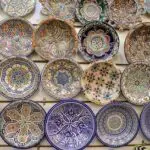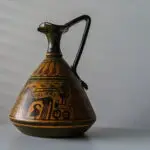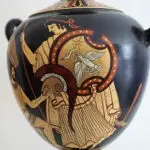Mediterranean pottery has a rich history, dating back to ancient times. It is known for its intricate designs and unique shapes, reflecting the cultural practices of ancient civilizations, especially the Greeks.
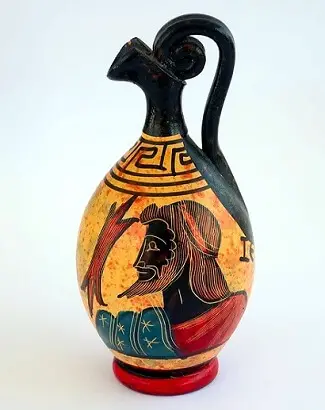
Greek pottery, in particular, gained fame for its black and red figure designs depicting mythology and everyday life. These designs were created using various techniques such as painting, carving, and incising. The pottery’s shapes, featuring slender necks and graceful curves, were both functional and aesthetically pleasing.
Today, Mediterranean pottery remains highly valued for its beauty and craftsmanship. While ancient Greek techniques and shapes have been preserved, modern potters have also embraced new materials and technologies.
Whether you’re an ancient artifact collector or simply appreciate the beauty of Mediterranean pottery, its enduring appeal is undeniable.
What is Mediterranean Pottery?
Mediterranean pottery refers to the ceramic vessels and objects that were produced and used in the Mediterranean region, which includes countries such as Italy, Greece, Spain, Turkey, and Egypt. Pottery has been an essential part of the Mediterranean culture for thousands of years, and it has played a significant role in the development of the region’s economy, trade, and art.
Mediterranean pottery is known for its distinctive shapes, designs, and colors, which reflect the different cultural influences that have shaped the region over time. The pottery produced in the Mediterranean region can be broadly classified into three categories based on their time period: prehistoric, ancient, and medieval.
Prehistoric Mediterranean pottery refers to the ceramic objects that were produced before the emergence of written records. These objects were often decorated with simple geometric patterns and were used primarily for cooking, storage, and ritual purposes.
Ancient Mediterranean pottery refers to the ceramic objects that were produced during the classical period of the Mediterranean world, which includes the Greek, Roman, and Byzantine empires. These objects were often decorated with intricate designs and were used for a wide range of purposes, including cooking, storage, transportation, and decoration.
Medieval Mediterranean pottery refers to the ceramic objects that were produced during the Middle Ages in the Mediterranean region. These objects were often decorated with Islamic, Christian, or Jewish motifs and were used for a wide range of purposes, including cooking, storage, and decoration.
In conclusion, Mediterranean pottery is an essential part of the region’s cultural heritage, and it continues to be produced and used today. The pottery produced in the Mediterranean region is known for its unique shapes, designs, and colors, and it reflects the diverse cultural influences that have shaped the region over time.
History of Mediterranean Pottery
Mediterranean pottery has a rich history dating back to ancient times. This section will explore the origins of Mediterranean pottery, its development in ancient Greece, and the subsequent evolution of the art form.
Origins of Mediterranean Pottery
The origins of Mediterranean pottery can be traced back to the Neolithic period, around 6000 BCE. Archaeological sites in Italy have revealed pottery fragments from this time period, which were likely used for cooking and storage.
During the Orientalizing period (8th century BCE), pottery production in Athens boomed. One of the most famous examples of this period is the Dipylon amphora, which was used to hold the ashes of the dead. These amphorae were decorated with intricate designs, including Near Eastern motifs, which were popular at the time.
Mediterranean Pottery in Ancient Greece
The Geometric period (9th-8th century BCE) saw the development of more complex designs and shapes in Mediterranean pottery. The pottery was used for practical and decorative purposes, with many pieces found in temples and other religious sites.
The Temple of Apollo at Delphi is an excellent example of using Mediterranean pottery in ancient Greece. The temple was adorned with painted vases and other pottery, which were used to honor the gods and goddesses.
Development of Mediterranean Pottery
During the Archaic period (6th century BCE), Mediterranean pottery continued to evolve. The pottery became more refined, with intricate designs and shapes. The pottery was also used for a wider range of purposes, including drinking vessels, storage containers, and decorative pieces.
Overall, the history of Mediterranean pottery is a testament to the creativity and ingenuity of ancient civilizations. From its humble origins in the Neolithic period to its development in ancient Greece, Mediterranean pottery has played an important role in human history.
Types of Mediterranean Pottery
Mediterranean pottery is a vast and diverse category of pottery that has evolved over centuries. The pottery of the Mediterranean region is known for its beautiful designs and intricate patterns. Each region has its own unique style, which makes Mediterranean pottery a fascinating subject to study.
Kouros and Kore
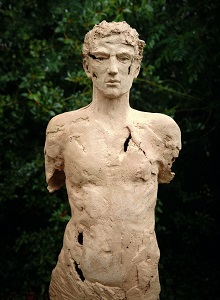
Kouros and Kore pottery is a type of ancient Greek pottery that was made during the Archaic period. The pottery is known for its distinctive black-figure style, which features black figures on a red background.
The pottery is named after the Kouros and Kore figures that are depicted on the pottery.
Kouros and Kore pottery was used for a variety of purposes, including funerary urns, drinking vessels, and decorative objects.
Acropolis Pottery
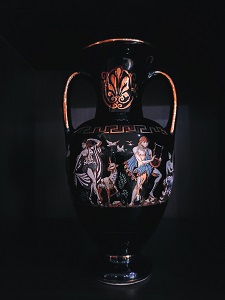
Acropolis pottery is a type of Greek pottery that was made in Athens during the 5th century BC. The pottery is known for its elegant shapes and beautiful designs.
Acropolis pottery was used for a variety of purposes, including drinking vessels, storage containers, and decorative objects.
The pottery was often decorated with scenes from Greek mythology, such as the labors of Heracles and the adventures of Theseus.
Polis Pottery
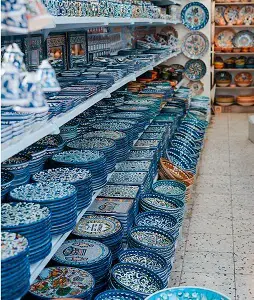
Polis pottery is a type of Greek pottery that was made in various city-states throughout Greece. The pottery is known for its simple shapes and functional designs.
Polis pottery was used for a variety of purposes, including cooking vessels, storage containers, and drinking vessels.
The pottery was often decorated with simple geometric patterns, such as stripes and dots.
Plaques and Graves
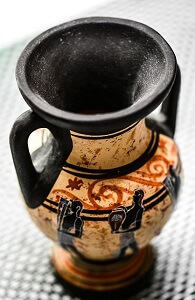
Plaques and Graves pottery is a type of Mediterranean pottery that was used for funerary purposes. The pottery was often made in the shape of a plaque or a grave marker and was used to commemorate the dead.
The pottery was often decorated with scenes from Greek mythology, such as the journey of the dead to the underworld.
In conclusion, Mediterranean pottery is a diverse and fascinating category of pottery that has evolved over centuries. Each region has its own unique style, which makes Mediterranean pottery a fascinating subject to study. Whether you are interested in the shapes, Greek pottery, or ancient Greek pottery, there is something for everyone in the world of Mediterranean pottery.
Techniques and Signatures
Pottery Making Techniques
Mediterranean pottery has a rich history that spans thousands of years. The techniques used to create these pieces have evolved over time, but some of the most common methods include coiling, slab construction, and wheel throwing. Coiling involves creating long, snake-like pieces of clay that are then stacked and smoothed together to form the desired shape. Slab construction involves rolling out flat pieces of clay and then cutting and piecing them together to create the desired form. Wheel throwing involves using a spinning wheel to shape the clay into the desired form.
The type of technique used depends on the desired outcome of the piece, as well as the skill level of the potter. Some pieces may be created using a combination of techniques to achieve the desired effect. For example, a potter may use coiling to create the base of a vase and then use slab construction to add decorative elements.
Signatures on Mediterranean Pottery
Mediterranean pottery is known for its intricate designs and unique signatures. These signatures can provide valuable information about the piece, such as the date it was created, the artist who created it, and the region it was made in.
One common type of signature found on Mediterranean pottery is the potter’s mark. This mark is typically a symbol or series of symbols that identify the potter who created the piece. These marks can vary widely in style and complexity, depending on the potter’s skill level and personal style.
Another type of signature found on Mediterranean pottery is the painter’s mark. This mark is typically a signature or series of initials that identify the artist who painted the piece. These marks can provide valuable information about the artist’s style and technique, as well as the region in which the piece was created.
In addition to these signatures, Mediterranean pottery may also feature decorative elements such as patterns, textures, and colors. These elements can provide valuable information about the region in which the piece was created, as well as the cultural and historical context in which it was made.
Overall, the techniques and signatures used in Mediterranean pottery reflect a rich history of craftsmanship and artistry. By studying these pieces, we can gain valuable insights into the cultures and traditions of the Mediterranean region.
Mediterranean Pottery Beyond Greece
While Greece is often considered the epicenter of Mediterranean pottery, there are many other regions that have contributed to the development of this art form. One such region is Sicily.
Mediterranean Pottery in Sicily
Sicily has a rich history of pottery production, with evidence of ceramic objects dating back to the 8th century BCE. The island’s strategic location in the Mediterranean made it a hub for trade and cultural exchange, which in turn influenced the development of its pottery traditions.
Sicilian pottery is characterized by its intricate designs and use of vibrant colors. Many pieces feature geometric patterns, while others depict scenes from daily life or mythological tales. The use of red and black figures on a white background is a common motif in Sicilian pottery.
One of the most famous types of Sicilian pottery is known as “pithos.” These large storage jars were used to store food and other goods and were often decorated with intricate designs. Pithos were also used as burial urns, and many examples have been found in ancient tombs on the island.
Another notable type of Sicilian pottery is the “gorgoneion.” These were small ceramic plaques featuring the face of the Gorgon Medusa, and were believed to have protective powers. Gorgoneion were often placed on the walls of houses or temples to ward off evil spirits.
Overall, Sicilian pottery is a testament to the island’s rich cultural heritage and its role in the development of Mediterranean art.
- The Top Restaurants Specializing in Truffle Dishes - August 10, 2023
- Truffle Panna Cotta: A Decadent Dessert Recipe for Truffle Lovers - August 7, 2023
- Truffle Scrambled Eggs: A Luxurious Breakfast Delight - August 7, 2023


